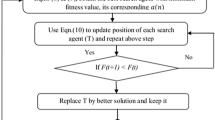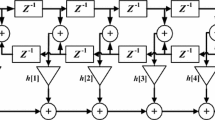Abstract
Intelligent optimization techniques are playing a very vital role in solving a wide variety of problems of engineering and technology of late. In order to meet the challenges from various perspectives, researchers are always in favor of applying those approaches to get rid of numerous practical difficulties of concern. Digital signal processing, more specifically the design of digital filters in particular, has been immensely motivated and beneficiated by means of this amalgamation. In this communication, we have incorporated a recently proposed genetic optimization method, named as self-organizing random immigrants genetic algorithm, in multiplier-free finite impulse response filter (FIR) design algorithm. Our study has focused on the selection of optimum settlement of filter coefficients through the utilization of this population-based technique which results in power of two distribution of impulse response over a binary search space. The performance of our designed filter has been thoroughly analyzed by a number of design parameters of interest and compared with other state-of-the-art multiplier-less FIR models. It has been observed that the proposed approach outperforms the other designs by a considerably large margin in those areas of signal processing where the reduction in hardware cost is the biggest challenge.





Similar content being viewed by others
References
Mitra, S.K.: Digital Signal Processing: A Computer-based Approach, 2nd edn. McGraw Hill, NY (2001)
Proakis, J.G.: Digital Signal Processing: Principles, Algorithms, and Applications. Prentice Hall, Englewood Cliffs (1997)
Nair, B.S.: Digital Signal Processing: Theory, Analysis and Digital-filter Design. Prentice-Hall, Englewood Cliffs (2004)
Tan, L.: Digital Signal Processing: Fundamentals and Applications. Academic Press, New York (2011)
Lim, Y.C., Parker, S.R.: FIR filter design over a discrete powers-of-two coefficient space. IEEE Trans. Acoust. Speech Signal Process. 31, 583–591 (1983)
Lim, Y.C., Parker, S.R.: Discrete coefficient FIR digital filter design based upon an LMS criteria. IEEE Trans. Circuits Syst. CAS–30(10), 723–739 (1983)
Li, D., Song, J., Lim, Y.C.: A polynomial-time algorithm for designing digital filters with power-of-two coefficients. In: Proceedings of the 1993 IEEE International Symposium for Circuits and Systems, vol. 1, pp. 84–87, 3–6 May (1993)
Lim, Y.C.: Design of discrete-coefficient-value linear phase FIR filters with optimum normalized peak ripple magnitude. IEEE Trans. Circuits Syst. 37, 1480–1486 (1990)
Zhao, Q., Tadokoro, Y.: A simple design of FIR filters with powers-of-two coefficients. IEEE Trans. Circuits Syst. 35(5), 566–570 (1988)
Samueli, H.: An improved search algorithm for the design of multiplier-less FIR filters with power-of-two coefficients. IEEE Trans. Circuits Syst. 36, 1044–1047 (1989)
Chen, C., Willson, A.N.: A trellis search algorithm for the design of FIR filters with signed-powers-of-two coefficients. IEEE Trans. Circuits Syst. II: Analog Digit. Signal Process. 46(1), 29–39 (1999)
Samueli, H.: The design of multiplierless digital data transmission filters with powers-of-two coefficients. In: Proceedings of the IEEE international telecommunications symposium, Rio de Janeiro, Brazil, pp. 425–429 (1990)
Yao, C.Y.: A study of SPT-term distribution of CSD numbers and its application for designing fixed-point linear phase FIR filters. In: Proceedings of the 2001 IEEE International Symposium for Circuits and Systems, vol. 2, pp. 301–304, 6–9 May (2001)
Kaakinen, J.Y., Saramaki, T.: A systematic algorithm for the design of multiplierless FIR filters. In: Proceedings of the 2001 IEEE International Symposium on Circuits and Systems, vol. 2, pp. 185–188, 6–9 May (2001)
Yu, Y.J., Lim, Y.C.: Signed power-of-two allocation scheme for the design of lattice orthogonal filter banks. In: Proceedings of the 2005 IEEE International Symposium on Circuits and Systems, vol. 2, pp. 1819–1822, 23–26 May (2005)
Xu, F., Chang, C.H., Jong, C.C.: Design of low-complexity FIR filters based on signed-powers-of-two coefficients with reusable common subexpressions. IEEE Trans. Comput. Aided Des. Integr. Circuits Syst. 26(10), 1898–1907 (2007)
Kwentus, A.Y., Jiang, Z., Willson, A.N.: Application of filter sharpening to cascaded integrator-comb decimation filters. IEEE Trans. Signal Process. 45(2), 457–467 (1997)
Storn, R.: Designing nonstandard filters with differential evolution. IEEE Signal Process. Mag. 22(1), 103–106 (2005)
Storn, R.: Differential evolution design of an IIR filter. In: Proceedings of the IEEE International Conference on Evolutionary Computation, pp. 268–273, 20–22 May (1996)
Karaboga, N.: Digital filter design using differential evolution algorithm. EURASIP J. Appl. Signal Process. 8, 1269–1276 (2005)
Luitel, B., Engelbrecht, A.P.: Differential evolution particle swarm optimization for digital filter design. In: Proceedings of the IEEE Congress on Evolutionary Computation, pp. 3954–3961, 1–6 June (2008)
Das, S., Abraham, A., Konar, A.: Particle swarm optimization and differential evolution algorithms: technical analysis, applications and hybridization perspectives. Stud. Comput. Intell. 116, 1–38 (2008)
Holland, J.H.: Adaptation in Natural and Artificial Systems. University of Michigan Press, Ann Arbor (1975)
Goldberg, D.E.: Genetic Algorithms in Search, Optimization and Machine Learning. Addison-Wesley, Reading, MA (1975)
Sivaraj, R., Ravichandran, T.: A review of selection methods in genetic algorithm. Int. J. Eng. Sci. Technol. 3(5), 3792–3797 (2011)
Grefenstette, J.J.: Genetic Algorithms for Changing Environments, Parallel Problem Solving from Nature 2, pp. 137–144. North Holland (2002)
Bak, P.: How Nature Works: The Science of Self-organized Criticality. Oxford University Press, Oxford (1997)
Tinos, R., Yang, S.: A self-organizing random immigrants genetic algorithm for dynamic optimization problems. Genet. Program. Evolvable Mach. 8(3), 255–286 (2007)
Mercier, P., Kilambi, S.M., Nowrouzian, B.: Optimization of FRM FIR digital filters over CSD and CDBNS multiplier coefficient spaces employing a novel genetic algorithm. J. Comput. 2(7), 20–31 (2007)
Ta, H.Q., Le-Nhat, T.: Design of FIR filter with discrete coefficients based on mixed integer linear programming. In: Proceedings of the 2008 \(9^{{\rm th}}\) International Conference on Signal Processing, pp. 9–12, 26–29 October (2008)
Yu, Y.J., Lim, Y.C.: Optimization of FIR filters in subexpression space with constrained adder depth. In: Proceedings of the 2009 \(6^{{\rm th}}\) International Symposium on Image and Signal Processing and Analysis, pp. 766–769, 16–18 September 2009
Cao, Y., Wang, K., Pei, W., Liu, Y., Zhang, Y.: Design of high-order extrapolated impulse response FIR filters with signed powers-of-two coefficients. Circuits Syst. Signal Process. 30(5), 963–985 (2011)
Ait-Boudaoud, D., Cemes, R.: Modified sensitivity criterion for the design of powers-of-two FIR filters. Electron. Lett. 29(16), 1467–1469 (1993)
Yeung, K.S., Chan, S.C.: Multiplier-less FIR digital filters using programmable sum-of-power-of-two (SOPOT) coefficients. In: Proceedings of the 2002 IEEE International Conference on Field-Programmable Technology, pp. 78–84, 16–18 December (2002)
Jheng, K., Jou, S., Wu, A.: A design flow for multiplierless linear-phase FIR filters: from system specification to verilog code. In: Proceedings of the 2004 IEEE International Symposium on Circuits and Systems, vol. 5, pp. 293–296, 23–26 May (2004)
Kaakinen, J.Y., Saramaki, T., Bregovic, R.: An algorithm for the design of multiplier-less two-channel perfect reconstruction orthogonal lattice filter banks. In: Proceedings of the First International Symposium on Control, Communications and Signal Processing, pp. 415–418 (2004)
Feng, Z.G., Teo, K.L.: A discrete filled function method for the design of FIR filters with signed-powers-of-two coefficients. IEEE Trans. Signal Process. 56(1), 134–139 (2008)
Chandra, A., Chattopadhyay, S.: A novel approach for coefficient quantization of low-pass finite impulse response filter using differential evolution algorithm. Signal Image Video Process. (2012). doi:10.1007/s11760-012-0359-4
Author information
Authors and Affiliations
Corresponding author
Rights and permissions
About this article
Cite this article
Chandra, A., Chattopadhyay, S. Novel design strategy of multiplier-less low-pass finite impulse response filter using self-organizing random immigrants genetic algorithm. SIViP 8, 507–522 (2014). https://doi.org/10.1007/s11760-013-0494-6
Received:
Revised:
Accepted:
Published:
Issue Date:
DOI: https://doi.org/10.1007/s11760-013-0494-6




